After months of laborious work from the eth2 analysis group, together with Consensys and DeepWork Studio, we’re comfortable to announce the discharge of the eth2 validator launchpad (testnet model).
We’re releasing it now so as to preserve monitor of, and make deposits into, the upcoming Medalla multi-client testnet. However we’ll proceed to fine-tune the interface within the run-up to mainnet launch.

The thought behind the launchpad is to make the method of turning into an eth2 validator as simple as attainable, with out compromising on safety and training.
In distinction to utilizing a third-party service, operating your personal validator comes with the accountability of managing your personal keys. This accountability brings with it an inescapable tradeoff between ease-of-use, safety, and training.
Training
The primary mission of the launchpad is to assist validators educate themselves about all points of the method. Above all, we wish to be certain that validators know what they’re doing, and why they’re doing it.
The fundamentals
We begin with the fundamentals. Earlier than you even start the sign-up course of, you must perceive what eth2 is, and why validators are vital for eth2 to work correctly.
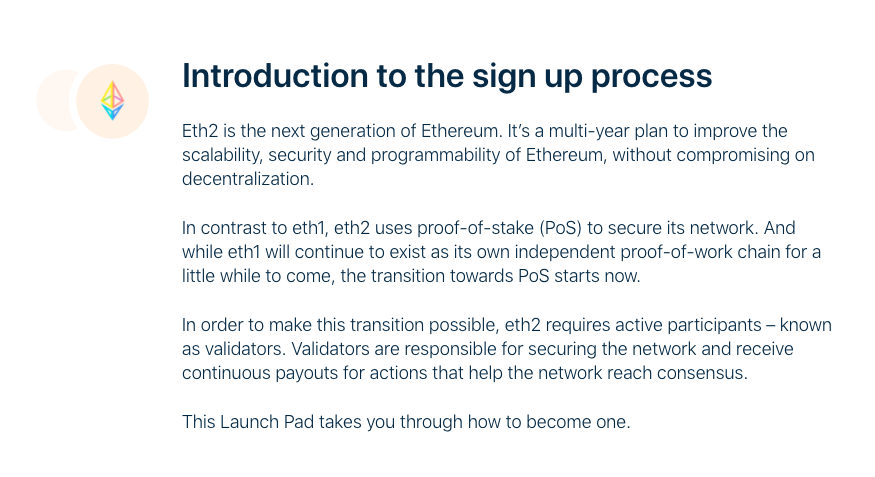
Timelines and milestones
You also needs to perceive that eth2 shall be launched in a number of phases.

And the place we presently stand in that timeline.
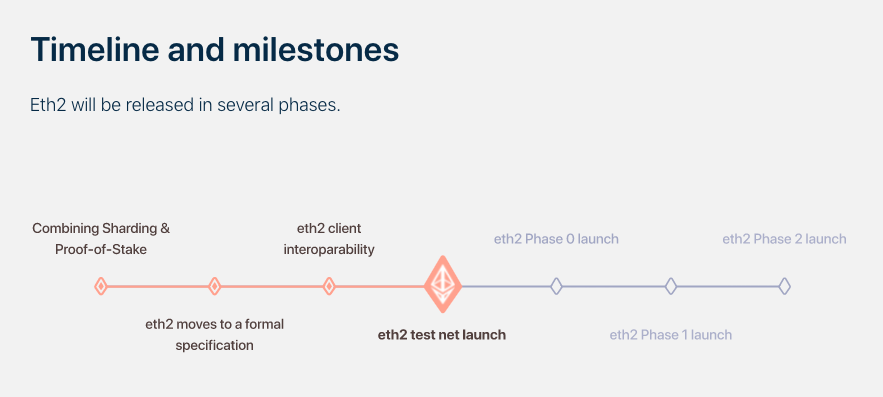
Rewards
Earlier than deciding whether or not to run a validator, it is vital to have a superb grasp on the quantity of rewards you stand to obtain.
Specifically, you must perceive that rewards aren’t mounted, however dynamic (a perform of the quantity of eth staked within the community).
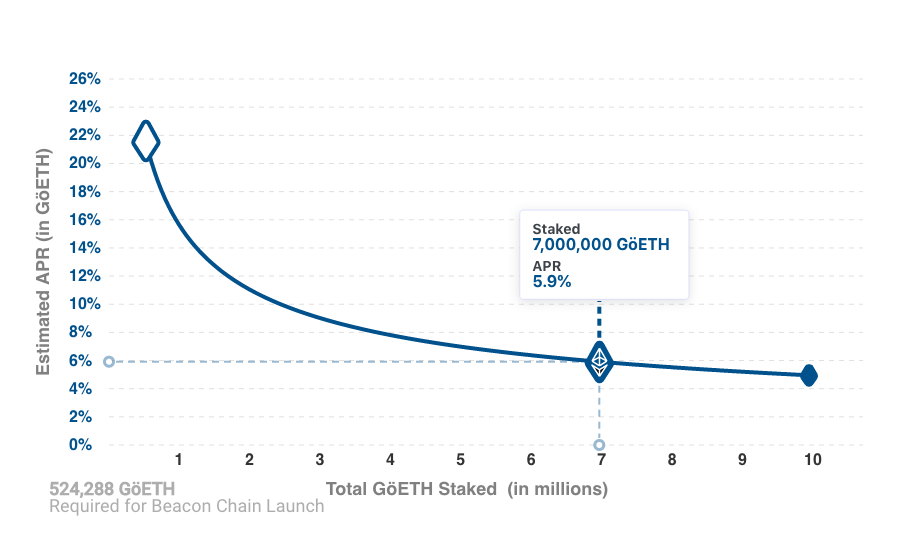
In plain English, if the whole quantity of ETH staked is low, the annual reward is excessive, however as the whole stake rises, the reward obtained by every validator begins to fall.
As soon as you are feeling you could have a superb grasp of the above ideas, you are prepared to start out the enroll course of.

The primary half consists of a collection of assertion pairs — a chunk of data adopted by an acknowledgment of the shape “I perceive this piece of data” — that may be broadly divided into three classes: danger, accountability, and safety (though there may be some overlap between all three).
Danger and accountability
The eth2 community can solely work efficiently if validators perceive their tasks and the dangers concerned.
With respect to danger, we wish you to know what your slashing dangers are, in addition to the inherent dangers concerned with being an early adopter.
With respect to accountability, we wish to ensure you perceive that you’ll solely obtain rewards for those who actively take part in consensus, and that this course of is non-reversible (you will not be capable of switch your staked ETH out of eth2 till a lot later).
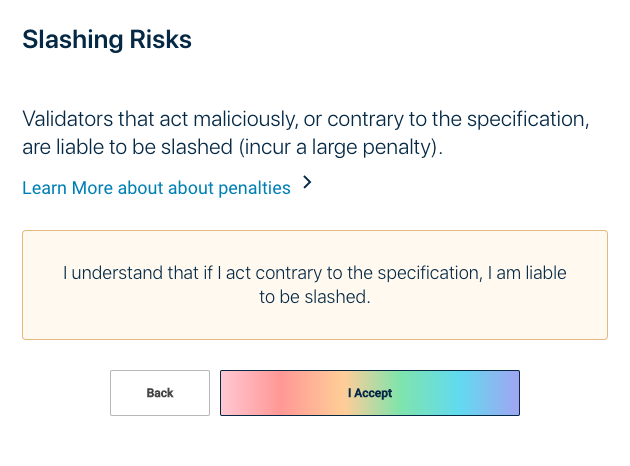
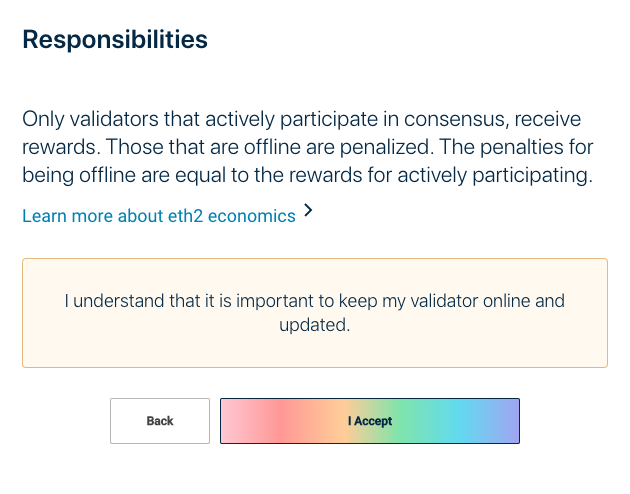
a few examples of assertion pairs
Safety (keys)
In distinction to becoming a member of a staking pool, operating your personal validator comes with the accountability of managing your personal keys.
Earlier than we leap into producing keys, we wish you to know what they do, and the way they’re created. Most significantly, you must perceive that your keys are derived from a novel mnemonic, and that you just will not be capable of withdraw your funds with out entry to this mnemonic.
Key technology
As soon as you’ve got accepted the dangers and tasks, the dapp instructs you on how you can use a separate command line interface (CLI) app to generate your keys offline.
What does this seem like, in follow?
1. Select most well-liked language
Upon coming into the interactive CLI you will be requested to decide on your most well-liked language
Please select your mnemonic language (czech, chinese_traditional, chinese_simplified, english, spanish, italian, korean) [english]:
2. Kind password to safe keystores & generate mnemonic
You may then be requested to kind a password
Kind the password that secures your validator keystore(s):
Appropriately confirming the password, generates your mnemonic (24 phrases which are used to generate your non-public keys).
3. Write down Mnemonic
Write it down and retailer it safely (you will want it to retrieve your deposit)
That is your seed phrase. Write it down and retailer it safely, it's the ONLY approach to retrieve your deposit. crater constructive retire course extensive arch ring zoo chief cup steak head spoon host about purchase throughout duck agency frog raccoon gasp exist legitimate Press any key when you could have written down your mnemonic.
4. Generate keys, keystores, and deposit information
Please kind your mnemonic (separated by areas) to verify you could have written it down:
As soon as you’ve got confirmed that you’ve got written down your mnemonic, you will get your keys:
##### ##### ## ##### ## ### ## ####### ######################### ## ## ##### ## ## ## ##### ## ## ## ## ## ### ######## ## #### ## ## ### ##### ##### # ## # ##### # # # ##### ## ## ## ## ## ## ## ### ## ## ############### ## ## ### ## ## ############################# ## ## ### ####### ################# ### ## ## ## ## ## ### ############## ############# Creating your keys. Saving your keystore(s). Creating your deposit(s). Verifying your keystore(s). Verifying your deposit(s). Success! Your keys could be discovered at: <YOUR_FOLDER_PATH>
That is it!
Transactions
As soon as you’ve got safely generated your keys, we information you thru the way you to add your public keys on-line, the place they may then be verified and despatched off to the deposit contract.
.
.
.
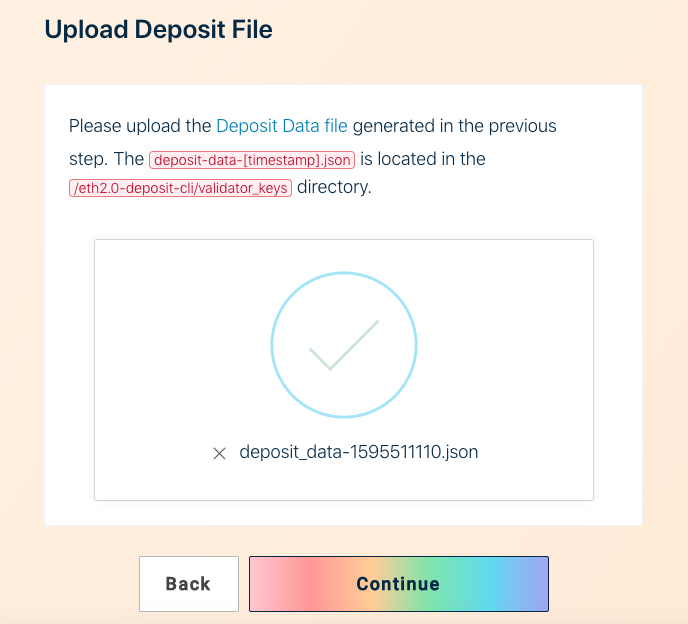
We confirm that the information you are importing is legitimate.
.
.
.

Double test that you just perceive a very powerful issues.
.
.
.

After which assist you to ship off these transactions.
.
.
.
.
.
.
And voila! That is all there may be to it. You’ve got successfuly deposited and dedicated to turning into a validator on eth2!
Now that you’ve got made your deposit, the subsequent step is to decide on your consumer (the software program you will use to arrange your Beacon Node, import your keystores, and run your Validator).
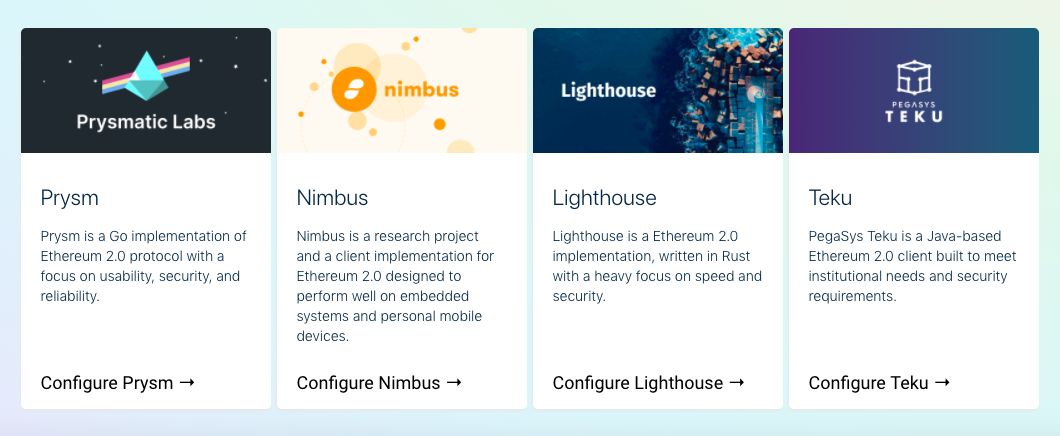
It seems like they will be no fewer than 4 shoppers operating at genesis — Lighthouse, Nimbus, Prysm, and Teku. Though the consumer groups will not have Medalla particular documentation prepared till nearer to August 4th, now might be a superb time to start out doing analysis on which consumer (or shoppers) you wish to check out. Take a look at their docs, mess around with their native testnets, and do not hesitate to get in contact straight with the groups (discord might be the place to go).
The Launchpad has been an vital challenge for us as one thing that may create a welcoming and academic expertise for beacon chain and eth2 onboarding. Nonetheless, we count on different nice interfaces to come back on-line over time from consumer operators and main groups, and we hope that you’re going to attempt their releases when the time comes too.
We hope you loved this easy walkthrough. We will not wait so that you can use the launchpad to make your Medalla testnet deposits 🎉
Particular due to each Consensys and DeepWork Studio 💙
P.S. If you would like a fundamental overview of what it means to be a validator in eth2, together with clear descriptions of the tasks concerned, you could be desirous about testing our FAQ.
P.P.S When you come throughout any points with the launchpad, please do not hesitate to report them here.









